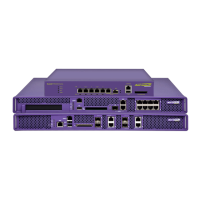Controller Services
Summit WM3000 Series Controller System Reference Guide238
DHCP Server Settings
The DHCP Server Settings section contains the following activities:
● Configuring the Controller DHCP Server
● Viewing the Attributes of Existing Host Pools
● Configuring Excluded IP Address Information
● Configuring the DHCP Server Relay
● Viewing DDNS Bindings
● Viewing DHCP Bindings
● Reviewing DHCP Dynamic Bindings
● Configuring the DHCP User Class
● Configuring DHCP Pool Class
Configuring the Controller DHCP Server
The controller contains an internal Dynamic Host Configuration Protocol (DHCP) Server. DHCP can
provide the dynamic assignment of IP addresses automatically. DHCP is a protocol that includes
mechanisms for IP address allocation and delivery of host-specific configuration parameters from a
DHCP server to a host. Some of these parameters are IP address, network mask and gateway.
When a DHCP server allocates an address for a client, the client is assigned a lease (which expires after
an interval defined by the administrator). Before the lease expires, clients are expected to renew the
lease to continue to use the addresses assigned. Once a lease has expired, the client to which that lease
was assigned is no longer permitted to use the leased IP address.
NTP Time
Management
Displays whether time management is currently enabled or disabled.
Network Time Protocol
(NTP) manages time and/or network clock
synchronization within the controller managed network. NTP is a client/
server implementation.
Redundancy Service
Displays whether Redundancy is currently enabled or disabled. One or
more controllers can be configured as members of a redundancy group to
significantly reduce the chance of a disruption in service to WLANs and
associated MUs in the event of failure of a controller or intermediate
network failure. For more information, see “Configuring Controller
Redundancy and Clustering” on page 270.
Layer 3 Mobility
Displays whether Layer 3 Mobility is currently enabled or disabled. Layer
3 mobility is a mechanism which enables a MU to maintain the same
Layer 3 address while roaming throughout a multi-VLAN network. This
enables the transparent routing of IP datagrams to MUs during their
movement, so data sessions can be initiated while they roam (in for voice
applications in particular). Layer 3 mobility enables TCP/UDP sessions to
be maintained in spite of roaming among different IP subnets. For more
information on configuring Layer 3 Mobility, see “When accessing the
controller Web UI through a NATed interface the Cluster GUI features will
only be accessible if TCP ports 80 and 161 are opened on the router or
gateway.” on page 284.

